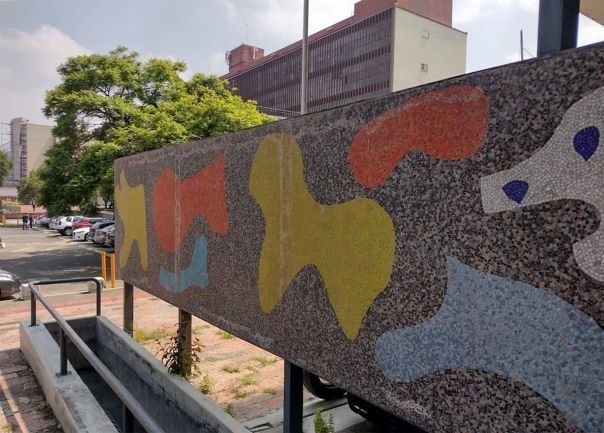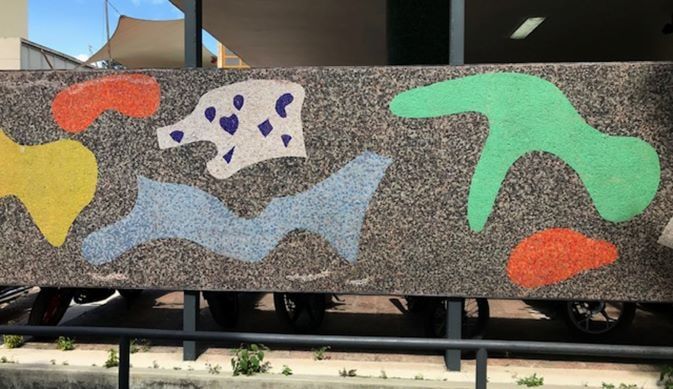Mysterious mural without name or author
Nobody knows either its name or the identity of the artist who designed it. This mural is composed of 18 abstract figures on a gray backdrop and runs down the north front of Building B of the Faculty of Chemistry in the University City.

Neither its name nor the artist who designed it is known. However, it has accompanied University City since its beginnings in 1952. Eighteen abstract figures on a gray background compose it, and it extends along the north façade of Building B of the Faculty of Chemistry-although originally the place housed the School of Veterinary Medicine-, perhaps that is why a handful of students place it in the university's imaginary as "the amoebas".
The missing details surrounding this mural make it "very special," said Aldo Solano, art historian and doctoral candidate at the Instituto de Investigaciones Estéticas. "Behind not knowing who did it, what it is about, and what it is called is the reason why we know almost nothing about it."
Of the original murals at the Central Campus, it is the only abstract mural. It is "peculiar because it is not attached directly to the wall of a building, it functions as a kind of panel that conceals the entrance. This puts it on a plane that is easier to understand than something that is just decorative. It is abstract and not so obviously participating in the architecture."
The building was designed by architects Fernando Barbará Zetina, Carlos Solórzano, and Félix Tena, three people whose relevant files on the projects they developed during their professional careers have not been preserved, making it difficult to obtain more details about the piece. Neither was it considered in the first guide to murals in University City written by journalist Alma Reed in 1957, nor is there any information about the work in the Institute of Research on the University and Education or the Archive of Mexican Architects.

Ignored
"It seems that this mural does not exist, no researcher has been interested in it, or because of the difficulty of finding information about it, it has been ignored and eliminated from the guides. What we can know is that it is very close to the artistic production of another architect, José Luis Benlliure, who participated in a very incipient way in University City as a draftsman and assistant architect, he was very young at that time," argued the historian and added:
"The Conjunto Aristos is José Luis Benlliure's most famous building and is, perhaps, one of the most successful in terms of architectural planning work, volumes, and dimensions. There are two murals there that are very much in tune with this one in terms of how they function in space, almost like a lattice, they are also very similar in terms of the material of Venetian mosaic tesserae and they are abstract in theme. There is formal closeness. It could be a possibility; however, of course, we can't attribute it to anyone because we don't have enough evidence."
One of the most popular theories refers that the unknown author of the mural is none other than the Guatemalan-born artist Carlos Merida, whose career was distinguished by a strong presence of abstract figures and geometric perspectives. The researcher added that the design is similar to the murals created by Mérida for the Community Center in Guatemala City.
Even with these possible links, there is not enough information that directly connects Mérida with this abstract mural: "by this time Carlos Mérida had already abandoned this type of figures, he used them in the 30's very influenced by surrealism. By 52, he was already completely in the geometrizing abstract, in another language, the Carlos Merida we know as mature."
"What makes this mural special and, I believe, is what has led it to be ignored by historiography is precisely its abstract subject matter. Without letting the imagination run wild, if we take into account that this was the Veterinary Annex, a kind of animal parade can be interpreted. It would be unfair to the artist to go back and reduce his abstraction to what it seems to us. If we compare it to other murals that are full of revolutionary ideology and easy-to-read iconography, this one may seem a bit more sterile, arider. Also, it is striking that it is not signed. That makes it special within the whole University City project."
"In the architectural magazines of the time and even in the newspapers, a famous page was published, a foldout that had the credits of all the technicians, architects, those who planted the plants, the urban planners, etcetera. In this obsession to give credit to all those who participated -and to show the people how massive this project was-, it is striking that this mural is not signed. My theory is that because it is abstract it is not signed, it is far from the production of official art at that time: murals full of iconography and post-revolutionary discourse," the specialist recalled.

Relevance
Despite its marked contrast with other works that accompanied the University City from the beginning, the abstract mural is not out of tune with the artistic and architectural trends of the 1950s, as Aldo Solano stated:
"It fits into an international trend of decorative murals in modern buildings, in lobbies, entrances, patios, etcetera. This one is very 1950s, rare in the context of University City because the others are full of content, they are figurative, not abstract, but this mural would be comfortable in many buildings around the world built in that same decade, in places where there was no post-revolutionary discourse. If we see it as evidence of the atmosphere of the art world at that time, it serves us well: an abstract mural in such a non-abstract context gives us a lot of information."
It is essential to understand the way Mexican art functioned at that time "because another group of artists dominated the scene and also that was the official art of the government, promoting these post-revolutionary discourses and this construction of the nation-state based on the mestizo identity." He gave as an example the work of Mathias Goeritz, an artist attacked during the 1950s for not contributing to the revolutionary art that prevailed in Mexico:
"Goeritz, for example, was one of the main promoters of abstract art, he received a lot of rejection at the end of the 50s. In 1952, that could have happened here: even though the muralists rejected abstract art -they said it was capitalist and imperialist compared to the art of the Revolution-. His mural at the School of Architecture -Poema Plástico- came later, it was late, and the school was already up and running".
He also proposed to make a comparison with the work of David Alfaro Siqueiros in the Rectory Tower, which is opposite, because "it has movement, it is full of instruction of reciprocity between the people and the university, it is designed to be seen from Insurgentes from the car at speed. This is a completely different case.
Despite the differences, this abstract mural has connections with its contemporaries, such as the technique in which it was made (Venetian mosaic) and its integration with the building that houses it.
"It must have been part of all this brightness that the University had, it was a completely new place, with avant-garde architecture, a mural with these characteristics pales before more spectacular things, such as the Central Library, for example. If we start comparing which is better or worse, I don't think it is of much use. We can understand how one can overshadow the other, at the end of the day not all murals became points of reference. If I say to someone 'let's meet in front of the Medicine mural', we are going to meet. If I tell you 'meet me at the mural in the Veterinary annex', you will still go to another faculty, because it has changed location," he said and added in conclusion:
"We don't have this mural located. It is logical, its dimensions are smaller, and it is not in a privileged place to be seen it is covered by some trees. It is a mural that seems shy because of its abstraction and because it is different from the others. This makes it one of the most mysterious objects in the University City".




